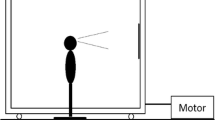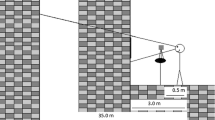Abstract
We exposed standing men and women to motion relative to the illuminated environment in a moving room. During room motion, we measured the kinematics of standing body sway. Participants were instructed to discontinue immediately if they experienced any symptoms of motion sickness, however mild. For this reason, our analysis of body sway included only movement before the onset of motion sickness. We analyzed the spatial magnitude of postural sway in terms of the positional variability and mean velocity of the center of pressure. We analyzed the multifractality of postural sway in terms of the width of the multifractal spectrum and the degree of multiplicativity of center of pressure positions. Results revealed that postural sway differed between participants who later reported motion sickness and those who did not, replicating previous effects. In a novel effect, postural responses to motion of the illuminated environment differed between women and men. In addition, we identified statistically significant interactions that involved both Sex and motion sickness status. Effects were observed separately in the spatial magnitude and multifractality of sway. The results were consistent with the postural instability theory of motion sickness (Riccio and Stoffregen in Ecol Psychol 3:195–240, 1991) and suggest that Sex differences in motion sickness may be related to Sex differences in the control and stabilization of bodily activity.








Similar content being viewed by others
References
Bonnet CT, Faugloire EM, Riley MA, Bardy BG, Stoffregen TA (2006) Motion sickness preceded by unstable displacements of the center of pressure. Hum Move Sci 25:800–820
Chen Y-C, Dong X, Chen F-C, Stoffregen TA (2012) Control of a virtual avatar influences postural activity and motion sickness. Ecol Psychol 24:279–299
Chiari L, Rocchi L, Cappello A (2002) Stabilometric parameters are affected by anthropometry and foot placement. Clin Biomech 17:666–677
Dijkstra TMH, Schöner G, Gielen CCAM (1994) Temporal stability of the action-perception cycle for postural control in a moving visual environment. Exper Brain Res 97:477–486
Dong X, Yoshida K, Stoffregen TA (2011) Control of a virtual vehicle influences postural activity and motion sickness. J Exper Psychol Appl 17:128–138
Era P, Sainio P, Koskinen S, Haavisto P, Vaara M, Aromaa A (2006) Postural balance in a random sample of 7,979 subjects aged 30 years and over. Gerontol 52:204–213
Faugloire E, Bonnet CT, Riley MA, Bardy BG, Stoffregen TA (2007) Motion sickness, body movement, and claustrophobia during passive restraint. Exper Brain Res 177:520–532
Flanagan MB, May JG, Dobie TG (2005) Sex differences in tolerance to visually-induced motion sickness. Aviat Space Environ Med 76:642–646
Forstberg J, Andersson E, Ledin T (1999) Influence of different conditions for tilt compensation on symptoms of motion sickness in tilting trains. Brain Res Bull 47:525–535
Giammarco EA, Schneider TJ, Carswell JJ, Knipe WS (2015) Video game preferences and their relation to career interests. Pers Individ Diff 73:98–104
Goldie PA, Bach TM, Evans OM (1989) Force platform measures for evaluating postural control: reliability and validity. Arch Phys Med Rehab 70:510–517
Golding JF (2006) Motion sickness susceptibility. Autonom Neurosci Basic Clin 129:67–76
Ihlen EA (2012) Introduction to multifractal detrended fluctuation analysis in Matlab. Front Physiol 3:141. doi:10.3389/fhys.201200141
Ihlen EA, Vereijken B (2013) Multifractal formalisms of human behavior. Hum Move Sci 32:633–651. doi:10.1016/j.humov.2013.01.008
Ihlen EA, Skjaeret N, Vereijken B (2013) The influence of center-of-mass movements on the variation in the structure of human postural sway. J Biomech 46:484–490
Kantelhardt JW, Zschiegner SA, Doscielny-Bunde E, Havlin S, Bunde A, Stanley HE (2002) Multifractal detrended fluctuation analysis of nonstationary time series. Phys A 316:87–114
Kelty-Stephen DG, Palatinus K, Saltzman E, Dixon JA (2013) A tutorial on multifractality, cascades, and interactivity for empirical times series in ecological science. Ecol Psychol 25:1–62
Kennedy RS, Lane NE, Berbaum KS, Lilienthal MG (1993) Simulator sickness questionnaire: an enhanced method for quantifying simulator sickness. Int J Aviat Psychol 3:203–220
Kennedy RS, Lanham DS, Massey CJ, Drexler JM, Lilienthal MG (1995) Gender differences in simulator sickness incidence: implications for military virtual reality systems. SAFE J 25:69–76
Kim JW, Eom GM, Kim CS, Kim DH, Lee JH, Park BK, Hong J (2010) Sex differences in the postural sway characteristics of young and elderly subjects during quiet natural standing. Geriat Geront Int 10:191–198
Kimura D (1997) Sex, sexual orientation and Sex hormones influence human cognitive functions. Biomed Rev 7:33–39
Klosterhalfen S, Kellerman S, Pan F, Stockhorst U, Hall G, Enck P (2005) Effects of ethnicity and gender on motion sickness susceptibility. Aviat Space Environ Med 76:1051–1057
Klosterhalfen S, Pan F, Kellerman S, Enck P (2006) Gender and race as determinants of nausea induced by circular vection. Gender Med 3:236–242
Koslucher FC, Haaland E, Stoffregen TA (2014) Body load and the postural precursors of motion sickness. Gait Pos 39:606–610
Koslucher FC, Haaland E, Malsch A, Webeler J, Stoffregen TA (2015) Sex differences in the incidence of motion sickness induced by linear visual oscillation. Aviat Med Hum Perform 86:787–793
Koslucher FC, Haaland E, Stoffregen TA (2016) Sex differences in visual performance and postural sway precede Sex differences in visually induced motion sickness. Exper Brain Res 234:313–322
Lamb S, Kwok KCS, Walton D (2013) Occupant comfort in wind-excited tall buildings: motion sickness, compensatory behaviors, and complaint. J Wind Eng Indus Aerodyn 119:1–12
Lawther A, Griffin MJ (1986) The motion of a ship at sea and the consequent motion sickness amongst passengers. Ergon 29:535–552
Lawther A, Griffin MJ (1988) A survey of the occurrence of motion sickness amongst passengers at sea. Aviat Space Environ Med 59:399–406
Lee DN, Lishman JR (1975) Visual proprioceptive control of stance. J Hum Mov Stud 1:87–95
Lin D, Seol H, Nussbaum MA, Madigan ML (2008) Reliability of COP-based postural sway measures and age-related differences. Gait Pos 28:337–342
Merhi O, Faugloire E, Flanagan M, Stoffregen TA (2007) Motion sickness, console video games, and head mounted displays. Hum Fact 49:920–934
Miller JW, Goodson JE (1960) Motion sickness in a helicopter simulator. Aerosp Med 31:204–212
Munafo J, Wade MG, Stoffregen TA (2016). The distance of visual targets affects the spatial magnitude and multifractal scaling of standing body sway in younger and older adults. Exp Brain Res (under review)
Nashner LM, McCollum G (1985) The organization of human postural movements: a formal basis and experimental synthesis. Behav Brain Sci 8:135–150
Oman CM (1982) A heuristic mathematical model for the dynamics of sensory conflict and motion sickness. Acta Otolaryngol 44(Suppl 392):4–44
Paillard AC, Quarck G, Paolino F, Denise P, Paolino M, Golding JF, Ghulyan-Bedikian V (2013) Motion sickness susceptibility in healthy subjects and vestibular patients: effects of gender, age, and trait-anxiety. J Vestib Res 23:203–210
Palatinus Z, Dixon JA, Kelty-Stephen DG (2013) Fractal fluctuations in quiet standing predict the use of mechanical information for haptic perception. Ann Biomed Eng 41:1626–1634
Park AHY, Hu S (1999) Gender differences in motion sickness history and susceptibility to optokinetic rotation-induced motion sickness. Aviat Space Environ Med 70:1077–1080
Reason JT (1978) Motion sickness adaptation: a neural mismatch model. J R Soc Med 71:819–829
Riccio GE, Stoffregen TA (1991) An ecological theory of motion sickness and postural instability. Ecol Psychol 3:195–240
Shimizu Y, Thurner S, Ehrenberger K (2002) Multifractal spectra as a measure of complexity in human posture. Fractals 10L:103–116. doi:10.1142/S0218348X02001130
Smart LJ, Stoffregen TA, Bardy BG (2002) Visually-induced motion sickness predicted by postural instability. Hum Fact 44:451–465
Stoffregen TA (1985) Flow structure versus retinal location in the optical control of stance. J Exper Psychol Hum Perc Perform 11:554–565
Stoffregen TA (2011) Le mal des transports comme trouble du mouvement [Motion sickness considered as a movement disorder]. Sci Motricité 74:19–30
Stoffregen TA, Smart LJ (1998) Postural instability precedes motion sickness. Brain Res Bull 47:437–448
Stoffregen TA, Hettinger LJ, Haas MW, Roe M, Smart LJ (2000) Postural instability and motion sickness in a fixed-base flight simulator. Hum Fact 42:458–469
Stoffregen TA, Bardy BG, Merhi O, Oullier O (2004) Postural responses to two technologies for generating optical flow. Presence 13:601–615
Stoffregen TA, Faugloire E, Yoshida K, Flanagan M, Merhi O (2008) Motion sickness and postural sway in console video games. Hum Fact 50:322–331
Stoffregen TA, Yoshida K, Villard S, Scibora L, Bardy BG (2010) Stance width influences postural stability and motion sickness. Ecol Psychol 22:169–191
Stoffregen TA, Chen F-C, Varlet M, Alcantara C, Bardy BG (2013) Getting your sea legs. PLoS ONE 8(6):e66949. doi:10.1371/jour-nal.pone.0066949
Stoffregen TA, Chen Y-C, Koslucher FC (2014) Motion control, motion sickness, and the postural dynamics of mobile devices. Exper Brain Res 232:1389–1397. doi:10.1007/s00221-014-3859-3
Sullivan EV, Rose J, Rohlfing T, Pfefferbaum A (2009) Postural sway reduction in aging men and women: relation to brain structure, cognitive status, and stabilizing factors. Neurobiol Aging 30:793–807
Thurner S, Mittermaier C, Hanel R, Ehrenberger K (2000) Scaling-violation phenomena and fractality in the human posture control system. Phys Rev E 62:4018–4024
Villard S, Flanagan MB, Albanese G, Stoffregen TA (2008) Postural instability and motion sickness in a virtual moving room. Hum Fact 50:332–345
Voyer D, Voyer S, Bryden MP (1995) Magnitude of Sex differences in spatial abilities: a meta-analysis and consideration of critical variables. Psychol Bull 117:250–270
Acknowledgments
We thank Eric Haaland, Amy Malsch, and Jennifer Webeler, who assisted with data collection and analysis. We thank also Damian Kelty-Stephen, for assistance with MF-DFA. This project was supported by the University of Minnesota’s Undergraduate Research Opportunities Program. Justin Munafo’s participation was supported by a fellowship from the University of Minnesota Diversity of Views and Experience program.
Author information
Authors and Affiliations
Corresponding author
Rights and permissions
About this article
Cite this article
Koslucher, F., Munafo, J. & Stoffregen, T.A. Postural sway in men and women during nauseogenic motion of the illuminated environment. Exp Brain Res 234, 2709–2720 (2016). https://doi.org/10.1007/s00221-016-4675-8
Received:
Accepted:
Published:
Issue Date:
DOI: https://doi.org/10.1007/s00221-016-4675-8




